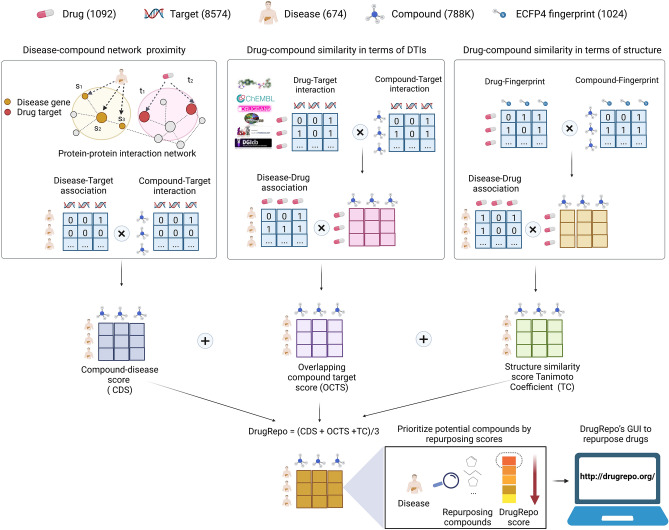Figure 1.
The schematic figure for drug repurposing in DrugRepo. The DrugRepo pipeline starts with the user selecting a particular disease. There are ~ 0.8 M candidate compounds in DrugRepo that can be repurposed or rescued for 669 diseases. At first, the pipeline finds approved drug(s) for the selected disease and searches for structurally similar drugs or compounds. In this step, the Tanimoto coefficient (TC) describes the structural similarity between molecular fingerprints (ECFP4) of approved and candidate compounds. A threshold is used to favor similar molecular structures. The second step is to compute DTI profiles for candidate compounds and approved drugs. The OCTS is the score based on overlapping DTIs between approved and candidate compounds. In case of multiple approved drugs for a disease, we took average of OCTS and TC scores. The third step is to compute the compound-disease score (CDS). The CDS is the average of the minimum distances in the PPI networks between target molecules and molecules associated with the selected disease. The average distance is normalized to 0–1. Finally, the DrugRepo score is calculated as the average of the three component scores. The higher the DrugRepo score between the approved drug and the candidate compound, the higher the possibility of repurposing the compound for a particular disease. Finally, we developed the DrugRepo’s GUI to provide a user-friendly service for repurposing drugs with our pipeline. The OCTS between approved and candidate compounds are computed using Eq. 1. The OCTS ranges from 0 to 1 and represents the proportion of targets shared between an approved drug and the candidate compounds. Candidate compounds sharing more targets with the approved drugs will have higher OCTS values.

